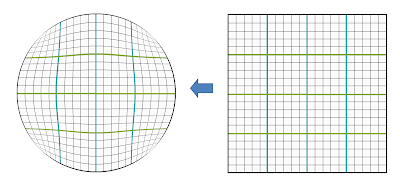The elliptical grid mapping is by no means the only way to map the square to a circle and vice versa.
In this entry, I shall introduce a disc to square mapping based on the Fernandez-Guasti squircle.
Here are the equations for the mapping.
square to circle:
u = x √(x² + y² - x²y²) / √(x² + y²)
v = y √(x² + y² - x²y²) / √(x² + y²)
circle to square:
x = √½ sgn(uv)/v √(u² + v² - √(u² + v²) √(u² + v² - 4u²v²) )
y = √½ sgn(uv)/u √(u² + v² - √(u² + v²) √(u² + v² - 4u²v²) )
where sgn(z) is the signum function;
(u,v) are circular coordinates in the domain {(u,v) | u² + v² ≤ 1}
(x,y) are square coordinates in the range [-1,1] x [-1,1]
Note: We need to handle zero inputs as a special case.
When input u or v is zero, just set x = u and y = v.
When input x or y is zero, just set u = x and v = y.
The main idea behind this mapping is to map concentric circles inside the circular disc to Fernandez-Guasti squircles inside the square.
C++ sample implementation below
--------------------------------------------------------------------------------------------------
// sample code accompanying the paper:
// "Analytical Methods for Squaring the Disc"
// http://arxiv.org/abs/1509.06344
#include <stdio.h>
#include <math.h>
#define epsilon 0.0000001
inline double sgn(double input)
{
double output = 1.0;
if (input < 0.0) {
output = -1.0;
}
return output;
}
// FG-Squircular mapping
// mapping a circular disc to a square region
// input: (u,v) coordinates in the circle
// output: (x,y) coordinates in the square
void fgsDiscToSquare(double u, double v, double& x, double& y)
{
x = u;
y = v;
double u2 = u * u;
double v2 = v * v;
double r2 = u2 + v2;
double uv = u * v;
double fouru2v2 = 4.0 * uv * uv;
double rad = r2 * (r2 - fouru2v2);
double sgnuv = sgn(uv);
double sqrto = sqrt(0.5 * (r2 - sqrt(rad)));
if (fabs(u) > epsilon) {
y = sgnuv/u * sqrto;
}
if (fabs(v) > epsilon) {
x = sgnuv/v * sqrto;
}
}
// FG-Squircular mapping
// mapping a square region to a circular disc
// input: (x,y) coordinates in the square
// output: (u,v) coordinates in the circle
void fgsSquareToDisc(double x, double y, double& u, double& v)
{
u = x;
v = y;
double x2 = x * x;
double y2 = y * y;
double r2 = x2 + y2;
double rad = sqrt( r2 - x2 * y2);
// avoid division by zero if (x,y) is closed to origin
if (r2 < epsilon) {
return;
}
// This code is amenable to the fast reciprocal sqrt floating point trick
// https://en.wikipedia.org/wiki/Fast_inverse_square_root
double reciprocalSqrt = 1.0/sqrt(r2);
u = x * rad * reciprocalSqrt;
v = y * rad * reciprocalSqrt;
}
int main()
{
double x,y;
double u,v;
fgsSquareToDisc(0.0,-0.789,u,v);
fgsDiscToSquare(u,v,x,y);
printf("%f %f\n",u,v);
printf("%f %f\n",x,y);
fgsDiscToSquare(-0.31415, -0.926535,x,y);
fgsSquareToDisc(x,y,u,v);
printf("%f %f\n",x,y);
printf("%f %f\n",u,v);
return 0;
}



No comments:
Post a Comment